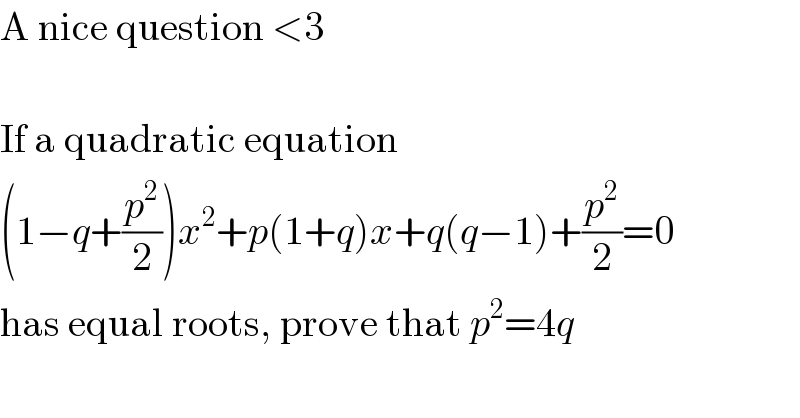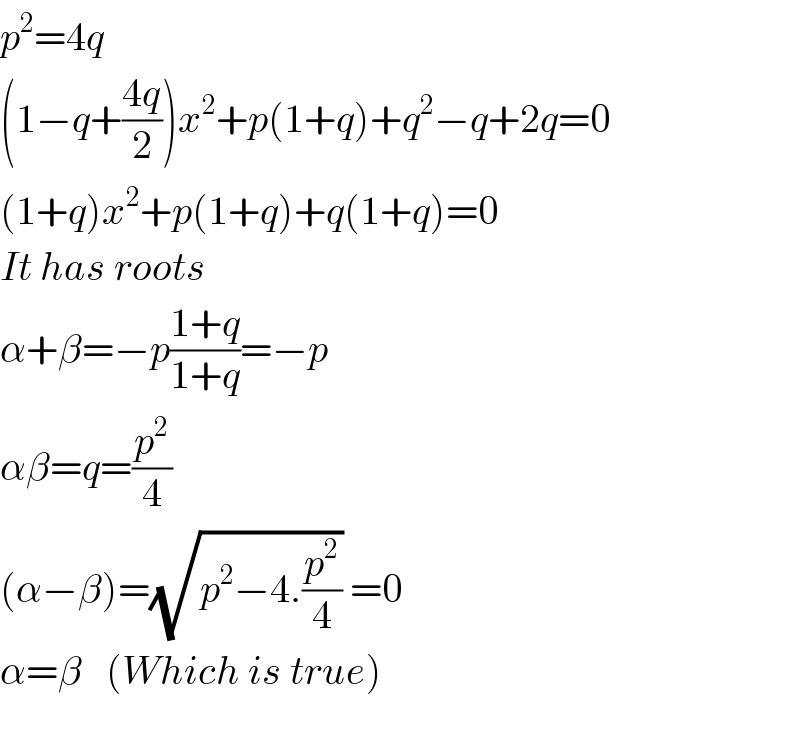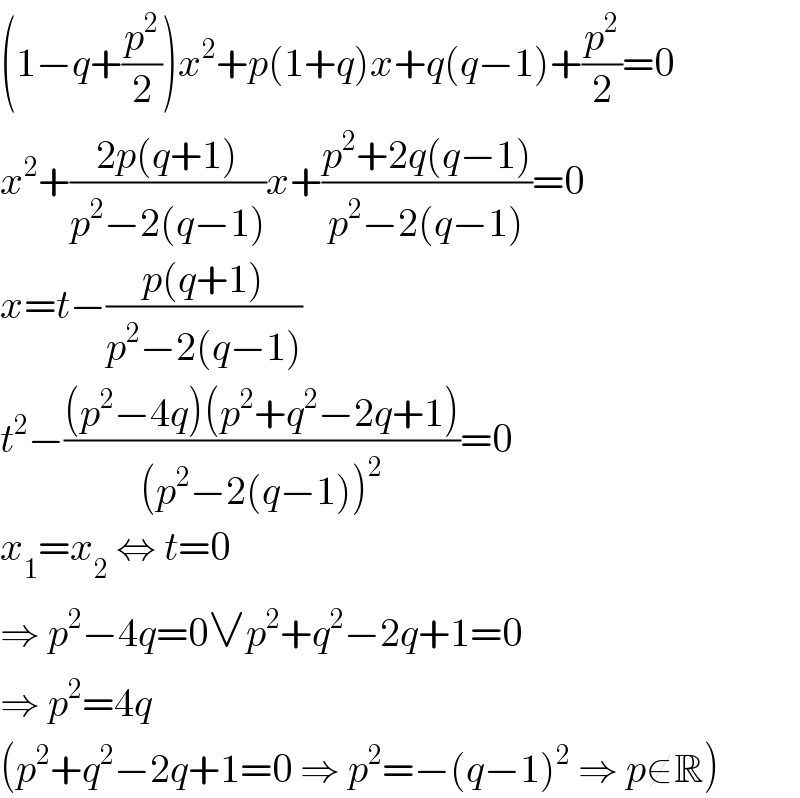Question Number 113684 by ZiYangLee last updated on 14/Sep/20

$$\mathrm{A}\:\mathrm{nice}\:\mathrm{question}\:<\mathrm{3} \\ $$$$ \\ $$$$\mathrm{If}\:\mathrm{a}\:\mathrm{quadratic}\:\mathrm{equation}\: \\ $$$$\left(\mathrm{1}−{q}+\frac{{p}^{\mathrm{2}} }{\mathrm{2}}\right){x}^{\mathrm{2}} +{p}\left(\mathrm{1}+{q}\right){x}+{q}\left({q}−\mathrm{1}\right)+\frac{{p}^{\mathrm{2}} }{\mathrm{2}}=\mathrm{0} \\ $$$$\mathrm{has}\:\mathrm{equal}\:\mathrm{roots},\:\mathrm{prove}\:\mathrm{that}\:{p}^{\mathrm{2}} =\mathrm{4}{q} \\ $$
Commented by Dwaipayan Shikari last updated on 14/Sep/20

$${p}^{\mathrm{2}} =\mathrm{4}{q} \\ $$$$\left(\mathrm{1}−{q}+\frac{\mathrm{4}{q}}{\mathrm{2}}\right){x}^{\mathrm{2}} +{p}\left(\mathrm{1}+{q}\right)+{q}^{\mathrm{2}} −{q}+\mathrm{2}{q}=\mathrm{0} \\ $$$$\left(\mathrm{1}+{q}\right){x}^{\mathrm{2}} +{p}\left(\mathrm{1}+{q}\right)+{q}\left(\mathrm{1}+{q}\right)=\mathrm{0} \\ $$$${It}\:{has}\:{roots} \\ $$$$\alpha+\beta=−{p}\frac{\mathrm{1}+{q}}{\mathrm{1}+{q}}=−{p} \\ $$$$\alpha\beta={q}=\frac{{p}^{\mathrm{2}} }{\mathrm{4}} \\ $$$$\left(\alpha−\beta\right)=\sqrt{{p}^{\mathrm{2}} −\mathrm{4}.\frac{{p}^{\mathrm{2}} }{\mathrm{4}}}\:=\mathrm{0} \\ $$$$\alpha=\beta\:\:\:\left({Which}\:{is}\:{true}\right) \\ $$$$ \\ $$
Answered by MJS_new last updated on 14/Sep/20

$$\left(\mathrm{1}−{q}+\frac{{p}^{\mathrm{2}} }{\mathrm{2}}\right){x}^{\mathrm{2}} +{p}\left(\mathrm{1}+{q}\right){x}+{q}\left({q}−\mathrm{1}\right)+\frac{{p}^{\mathrm{2}} }{\mathrm{2}}=\mathrm{0} \\ $$$${x}^{\mathrm{2}} +\frac{\mathrm{2}{p}\left({q}+\mathrm{1}\right)}{{p}^{\mathrm{2}} −\mathrm{2}\left({q}−\mathrm{1}\right)}{x}+\frac{{p}^{\mathrm{2}} +\mathrm{2}{q}\left({q}−\mathrm{1}\right)}{{p}^{\mathrm{2}} −\mathrm{2}\left({q}−\mathrm{1}\right)}=\mathrm{0} \\ $$$${x}={t}−\frac{{p}\left({q}+\mathrm{1}\right)}{{p}^{\mathrm{2}} −\mathrm{2}\left({q}−\mathrm{1}\right)} \\ $$$${t}^{\mathrm{2}} −\frac{\left({p}^{\mathrm{2}} −\mathrm{4}{q}\right)\left({p}^{\mathrm{2}} +{q}^{\mathrm{2}} −\mathrm{2}{q}+\mathrm{1}\right)}{\left({p}^{\mathrm{2}} −\mathrm{2}\left({q}−\mathrm{1}\right)\right)^{\mathrm{2}} }=\mathrm{0} \\ $$$${x}_{\mathrm{1}} ={x}_{\mathrm{2}} \:\Leftrightarrow\:{t}=\mathrm{0} \\ $$$$\Rightarrow\:{p}^{\mathrm{2}} −\mathrm{4}{q}=\mathrm{0}\vee{p}^{\mathrm{2}} +{q}^{\mathrm{2}} −\mathrm{2}{q}+\mathrm{1}=\mathrm{0} \\ $$$$\Rightarrow\:{p}^{\mathrm{2}} =\mathrm{4}{q} \\ $$$$\left({p}^{\mathrm{2}} +{q}^{\mathrm{2}} −\mathrm{2}{q}+\mathrm{1}=\mathrm{0}\:\Rightarrow\:{p}^{\mathrm{2}} =−\left({q}−\mathrm{1}\right)^{\mathrm{2}} \:\Rightarrow\:{p}\notin\mathbb{R}\right) \\ $$
Commented by ZiYangLee last updated on 15/Sep/20

$$\mathrm{Cool}! \\ $$
